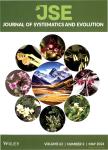Climatic envelope of evergreen sclerophyllous oaks and their present distribution in the eastern Himalaya and Hengduan Mountains
Climatic envelope of evergreen sclerophyllous oaks and their present distribution in the eastern Himalaya and Hengduan Mountains作者机构:(Key Laboratory of Biodiversity and Biogeography Kunming Institute of Botany Chinese Academy of Sciences Kunming 650204 China) (Graduate University of Chinese Academy of Sciences Beijing 100049 China)
出 版 物:《Journal of Systematics and Evolution》 (植物分类学报(英文版))
年 卷 期:2009年第47卷第3期
页 面:183-190页
核心收录:
基 金:supported by the State Key Basic Research and Development Plan of China (973) (2003CB415102) the National Natural Science Foundation of China (30170077, 30670159)
主 题:climatic indices distribution limits multiple regression analysis principal components analysis Quercus section Heterobalanus.
摘 要:Evergreen sclerophyllous oaks (the E.S. oaks, Quercus section Heterobalanus) are the dominant species of the local ecosystem in the eastern Himalaya and the Hengduan Mountains, southwest China. In this study, we document the climatic envelope of the seven E.S. oak species and examine the relationships between climate and their distribution. This was done using a principal components analysis (PCA) and multiple regression analysis (MRA) of nine climatic indices. The main climatic envelope of the E.S. oaks were: mean temperature of the warmest month (MTW)=12.0-19.5 ℃, warmth index (WI) = 33.2-88.9 ℃ month, annual biotemperature (BT)=-6.9--0.3 ℃, coldness index (CI)=-30.4- -10.1 ℃ month, mean temperature of the coldest month (MTC)=-3.7-3.0 ℃ and annual precipitation (AP)=701-897 mm at the lower limits; and MTW=8.3-16.1 ℃, WI=15.7-59.1 ℃ month, BT=3.6-8.9 ℃, CI=-55.4--19.3 ℃ month, MTC=8.3-16.1 ℃ and AP=610-811 mm at the upper limits. The climatic range of the E.S. oaks is wide and includes two climatic zones, the cool-temperature zone and the subpolar zone. The PCA and MRA results suggest that the thermal climate plays a major role and precipitation plays a secondary role in controlling the large-scale distribution of the E.S. oaks, except Quercus monimotricha. In thermal regimes, BT and/or MTW are most important for both lower and upper limits of the E.S. oaks. Furthermore, our results indicate that the upper distribution limits of the E.S. oaks are less determined by low temperatures and their duration (CI) than by other factors.



